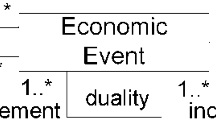Abstract
In recent years, considerable attention has been paid to enterprise information systems. This interest is motivated by the need for achieving better integration of new technologies (hardware and software) with the business processes of an organization. Business processes have become more and more dependent on technologies because technology has a direct impact on business processes, changing the way they are performed and thus also affecting the way analysts design the software system. However, at the present time, there are still some gaps between the definition of business processes and the technologies used in the organization. In practice, organizations have carried out their business processes using different technologies; however, it is sometimes not possible to determine how technologies are useful in achieving current business goals. This is because business models do not explicitly consider the technologies in the organizational requirements. The goal of this paper is to present a systematic process for integrating business processes and technologies at the conceptual level. To validate our approach, we present a case study that describes the processes of the inventory management department of a public research center.










Similar content being viewed by others
References
Bandara W, Indulska M, Chong S, Sadiq S (2007) Major issues in business process management: an expert perspective. In: ECIS 2007—the 15th european conference on information systems, University of St. Gallen, St Gallen, Switzerland, pp 1240–1251. http://eprints.qut.edu.au/14345/
Bouwman H, den Hooff V, van de Wijngaert L, van Dijk J (2005) Information and communication technology in organizations: adoption, implementation, use and effects. SAGE Publications. http://books.google.com.mx/books?id=FzaHAcHhOHYC
Bresciani P, Perini A, Giorgini P, Giunchiglia F, Mylopoulos J (2004) Tropos: an agent oriented software development methodology. Auton Agents Multi-Agent Syst 8(3):203–236
Cares C, Franch X (2011) A metamodelling approach for i* model translations. In: CAiSE, pp 337–351
Castro J, Kolp M, Mylopoulos J (2002) Towards requirements-driven information systems engineering: the tropos project. Inf Syst 27(6):365–389. doi:10.1016/S0306-4379(02)00012-1
Dardenne A, van Lamsweerde A, Fickas S (1993) Goal-directed requirements acquisition. Sci Comput Program 20(1–2):3–50. doi:10.1016/0167-6423(93)90021-G
Eriksson HE, Penker M (1998) Business modeling with UML: business patterns at work, 1st edn. Wiley, New York
Estrada H, Martinez A, Santillan L, Perez J (2013) A new service-based approach for enterprise modeling. Comput Syst J 17(4):625–639. doi:10.13053/CyS-17-4-2013-013. http://cys.cic.ipn.mx/ojs/index.php/CyS/article/view/1930/1860
Estrada H (2008) A service-oriented approach for the i* framework. Ph.D. thesis, Universidad Politecnica de Valencia
Estrada H, Martinez A, Pastor O, Mylopoulos J, Giorgini P (2010) Extending organizational modeling with business services concepts: an overview of the proposed architecture. In: Proceedings of the 29th international conference on Conceptual modeling, ER’10. Springer, Berlin, pp 483–488. http://dl.acm.org/citation.cfm?id=1929757.1929807
Franch X (2010) Incorporating modules into the i* framework. In: Pernici B (ed) Advanced information systems engineering, Lecture Notes in Computer Science, vol 6051, pp 439-454. Springer Berlin. doi:10.1007/978-3-642-13094-634. http://dx.doi.org/10.1007/978-3-642-13094-6_34
General Direction for Materials Resources (2007) Proceedings manual for management the services and goods in Educational Institutions from Public Education Secretary
Group TO (2011) TOGAF Version 9.1. http://pubs.opengroup.org/architecture/togaf9-doc/arch/
ISO (19440:2007) Enterprise integration—Constructs for enterprise modelling. https://www.iso.org/obp/ui#iso:std:iso:19440:ed-1:v1:en. Accessed 08 Nov 2015
Jonkers H, Lankhorst MM, van Buuren R, Hoppenbrouwers S, Bonsangue MM, van der Torre LWN (2004) Concepts for modeling enterprise architectures. Int J Coop Inf Syst 13(3):257–287
Lankhorst M, Proper H, Jonkers H (2009) The architecture of the archimate language. In: Halpin T, Krogstie J, Nurcan S, Proper E, Schmidt R, Soffer P, Ukor R (eds) Enterprise, business-process and information systems modeling. Lecture notes in business information processing, vol 29, pp 367–380. Springer Berlin (2009). doi:10.1007/978-3-642-01862-630. http://dx.doi.org/10.1007/978-3-642-01862-6_30
Lillehagen F, Krogstie J (2008) State of the art of enterprise modeling. In: Active knowledge modeling of enterprises. Springer, Berlin, pp 91–127. doi:10.1007/978-3-540-79416-5_4
Lopez L, Costal D, Ayala CP, Franch X, Annosi MC, Glott R, Haaland K (2015) Adoption of OSS components: a goal-oriented approach. Data Knowl Eng 99:17–38. doi:10.1016/j.datak.2015.06.007
Martinez A (2008) Conceptual schemas generation from organizational models in an automatic software production process. Ph.D. thesis, Universidad Politecnica de Valencia
Monsalve ES, do Prado Leite JCS (2013) Using i* for transparent pedagogy. In: Castro J, Horkoff J, Maiden NAM, Yu ESK (eds) Proceedings of the 6th international i* workshop 2013, Valencia, Spain, June 17–18, 2013, CEUR Workshop Proceedings, vol 978, pp 25–30. CEUR-WS.org. http://ceur-ws.org/Vol-978/paper_5
Montilva J, Barrios J (2004) BMM: a business modeling method for information systems development. CLEI, vol 7. http://www.clei.org/cleiej/papers/v7i2p3
Morales E, Franch X, Martinez A, Estrada H (2011) Considering technology representation in service-oriented business models. In: Computer software and applications conference workshops (COMPSACW), 2011 IEEE 35th Annual, pp 482–487. doi:10.1109/COMPSACW.2011.87
Morales E, Franch X, Martinez A, Estrada H, Pastor O (2011) Technology representation in * modules. In: iStar’11, pp 78–83
Najera K, Vazquez B, Martinez A, Perini A, Estrada H, Morandini M (2013) TAGOOn+: generation and integration of organizational ontologies, vol 978, pp 125–127. http://ceur-ws.org/Vol-978/paper_22
National Center for Research and Technological Development (2009) Organizational manual for Materials Resources and services department
Santillan L (2013) Creation of a method from organizational modeling focused in technologies. Ph.D. thesis, National Center for Research and Technological Development
Yu E, Giorgini P, Maiden N, Mylopoulos J (2011) Social modeling for requirements engineering. The MIT Press, Cambridge
Yu E (1996) Modelling strategic relationships for process reengineering. Ph.D. thesis, University of Toronto, Canada
Zachman JA (1999) A framework for information systems architecture. IBM Syst J 38(2/3):454–470
Author information
Authors and Affiliations
Corresponding author
Rights and permissions
About this article
Cite this article
Martinez, A., Vazquez, B., Estrada, H. et al. Incorporating technology in service-oriented i* business models: a case study. Inf Syst E-Bus Manage 15, 461–487 (2017). https://doi.org/10.1007/s10257-016-0316-9
Received:
Revised:
Accepted:
Published:
Issue Date:
DOI: https://doi.org/10.1007/s10257-016-0316-9




